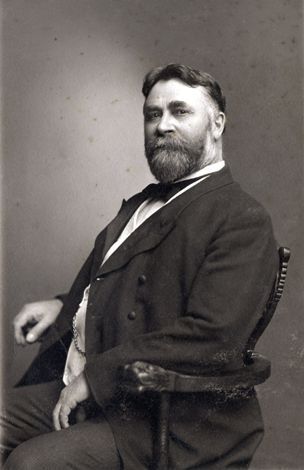Captain Marcus Motier Drake (1835-1907)
Marquis (Marcus) Motier Drake was born in Homer, Cortland County, New York on September 7, 1835. It is possible that he was named for the Revolutionary War hero Gilbert du Motier, Marquis de Lafayette, who had visited Cortland County on his tour of America in 1824. When Marcus Drake was two years old, his family moved from Cortland County to Fredonia in Chautaqua County, where his maternal grandparents then lived. Shortly after that, in 1840, the family moved to nearby Sheridan, where they farmed. Marcus attended local schools and the Fredonia Academy, and in 1851, he left home to become a sailor on the Great Lakes. He was a steamer mate by 1855 and served as an officer on steam and sailing vessels. In 1860, he was was appointed Captain of the propeller Genesee, chief vessel of the Erie Line between Buffalo and Erie. Following the outbreak of the Civil War, he volunteered for the Union Army, accepting a substantial pay cut to serve with the 72nd New York Volunteers through three years of combat, ultimately reaching the rank of First Lieutenant. After the war, he returned to the Erie fleet of ferries as a captain. He also changed his name to Marcus at that time. In 1869, he was appointed Superintendant of Repairs of the Union Steamboat Company, which was controlled by the Erie lines, and two years later, Superintendant of the Union Dry Dock Co. In 1889, he left the Erie lines to become superintendant of his own Lackawanna Transportation Company.
On August 13, 1860, he married Persis L. Bennett, who died little more than a year later, on September 3, 1861. On December 19, 1867, he married Mary A. Ludlow, daughter of Captain Charles H. Ludlow, another Great Lakes captain, who had died in 1859. They were married in Buffalo and lived in the Ludlow family home on Niagara Street. Marcus and Mary had seven children together before her death in 1880. Their surviving children were Frank Schuyler Drake, George Babcock Drake, Mary Ludlow Drake, Elizabeth Guest Drake, Marcus Motier Drake II, and Jane Ludlow Drake. All but Frank were educated at Cornell University, and Jane, who married Frank Abbott, became a noted author of young adult books. The youngest, Charles Ludlow Drake, died in infancy shortly after her death, and while Marcus was in Sheridan for the funeral of his father. Marcus married a third time in 1901, to Lillian Quast Lacey.
In 1878, Marcus began his political career as alderman for the 12th ward in Buffalo, a position he maintained until 1890. In November, 1882, he was appointed Mayor when Grover Cleveland left the office to become Governor. Marcus stepped down just over a month later. In 1896, he was appointed Commissioner of the Public Works, a position he held for three years.
Marcus Drake died on September 28, 1907

From the San Jose Mercury and Herald, Sunday, October 6, 1907.
CAPTAIN MARCUS DRAKE DIES IN BUFFALO, N.Y.
Was Executor in Santa Clara County of the Estate of Helen S. Wright.
Soldier of War of Secession, Who Had Won National Reputation.
The numerous friends in this community of Captain and Mrs. Marcus M. Drake of Buffalo, New York, will be pained to learn that Captain Drake died at his home in Buffalo on the 28th of September.
Captain and Mrs. Drake spent several winters in San Jose, and by their whole-souled and genial manner endeared themselves to a large circle of friends here.
Captain Drake was a man of national reputation. He filled many public offices in New York State, was associated with ex-President Grover Cleveland in the city government of Buffalo and succeeded him as its Mayor.
He was a distinguished member of the Grand Army of the Republic, having fought with distinction at the battle of Gettysburg in July, 1863, and was one of the men that carried his old commander, General Daniel E. Sickles, twelve miles to a hospital after the General was severely wounded.
When the field of Gettysburg was dedicated as a National cemetery, Captain Drake was present, at the invitation of the Government, to locate the positions of the contending forces in that great battle for the purpose of setting the permanent monuments.
He was largely interested in iron mines on Lake Superior and developed others in Western New York.
He was heavily interested in shipping on the Great Lakes, and when he was about to start for the St. Louis Exposition with his wife, a strike tied up all the shipping on the lakes. Although Captain Drake had not taken command of any of his ships for over twenty years, his grit and determination asserted itself and he decided that one of his ships, then loaded in the harbor of Buffalo, should sail on time if he had to take command of her himself. He picked up a crew and started on his perilous voyage, ran her ashore twice, but finally moored his cargo safe in the harbor of Chicago.
Captain Drake was the executor in this county of the estate of Helen S. Wright, who was prominently identified with the State Normal School, and with the assistance of Henry French, his attorney, closed up and distributed that large and complicated estate among thirty heirs.
Captain Drake was of heroic mould, a man of commanding presence, kind, genial, and whole-souled, was an active member and worker in the Episcopal Church, and a high type of American citizenship.
The sincere sympathy of a large host of friends in Santa Clara county goes forth to his loyal and devoted companion, Lillian R. Drake, in this, her great loss and sorrow.
Return to main page